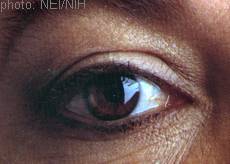
progressive external ophthalmoplegia
Progressive external ophthalmoplegia is a condition characterized by weakness of the eye muscles. The condition typically appears in adults between ages 18 and 40. The most common signs and symptoms of progressive external ophthalmoplegia are drooping eyelids (ptosis), which can affect one or both eyelids, and weakness or paralysis of the muscles that move the eye (ophthalmoplegia). Affected individuals may also have general weakness of the skeletal muscles (myopathy), particularly in the neck, arms, or legs. The weakness may be especially noticeable during exercise (exercise intolerance). Muscle weakness may also cause difficulty swallowing (dysphagia).
When the muscle cells of affected individuals are stained and viewed under a microscope, these cells usually appear abnormal. These abnormal muscle cells contain an excess of structures calledmitochondria and are known as ragged-red fibers. Additionally, a close study of muscle cells may reveal abnormalities in a type of DNA found in mitochondria called mitochondrial DNA (mtDNA). Affected individuals often have large deletions of genetic material from mtDNA in muscle tissue.
Although muscle weakness is the primary symptom of progressive external ophthalmoplegia, this condition can be accompanied by other signs and symptoms. In these instances, the condition is referred to as progressive external ophthalmoplegia plus (PEO+). Additional signs and symptoms can include hearing loss caused by nerve damage in the inner ear (sensorineural hearing loss), weakness and loss of sensation in the limbs due to nerve damage (neuropathy), impaired muscle coordination (ataxia), a pattern of movement abnormalities known as parkinsonism, or depression.
Progressive external ophthalmoplegia is part of a spectrum of disorders with overlapping signs and symptoms. Similar disorders include other conditions caused by POLG gene mutations, such as ataxia neuropathy spectrum, as well as other mtDNA deletion disorders, such as Kearns-Sayre syndrome. Like progressive external ophthalmoplegia, the other conditions in this spectrum can involve weakness of the eye muscles. However, these conditions have many additional features not shared by most people with progressive external ophthalmoplegia.
Eyelid Disorders Update
MedlinePlus sent this bulletin at 04/18/2016 01:11 PM EDTNew on the MedlinePlus Eyelid Disorders page:

04/13/2016 02:39 PM EDT

Source: National Library of Medicine - 

04/13/2016 02:39 PM EDT

Source: National Library of Medicine - 

04/13/2016 02:39 PM EDT

Source: National Library of Medicine - 

National Institutes of Health
Your eyelids help protect your eyes. When you blink, your eyelids spread moisture over your eyes. Blinking also helps move dirt or other particles off the surface of the eye. You close your eyelids when you see something coming towards your eyes. This can help protect against injuries.
Like most other parts of your body, your eyelids can get infected, inflamed, or even develop cancer. There are also specific eyelid problems, including
- Eyelids that turn in or out
- Eyelids that droop
- Abnormal blinking or twitching
Treatment of eyelid problems depends on the cause.
- Vision Symptoms (American Academy of Ophthalmology)Available in Spanish
- Blepharoplasty - slideshow Available in Spanish
- Eyelid Cancer (American Society of Clinical Oncology)
- Benign Essential Blepharospasm
 (National Institute of Neurological Disorders and Stroke) - Short Summary
(National Institute of Neurological Disorders and Stroke) - Short Summary - Blepharitis (American Academy of Ophthalmology)Available in Spanish
- Blepharitis
 (National Eye Institute)
(National Eye Institute) - Chalazia and Styes (American Academy of Ophthalmology)Available in Spanish
- Eye Twitching (Mayo Foundation for Medical Education and Research)
- Facts about Blepharospasm
 (National Eye Institute)
(National Eye Institute) - Meibomian Gland Dysfunction and Treatment (Posterior Blepharitis) (American Association for Pediatric Ophthalmology and Strabismus)
- Sty (Mayo Foundation for Medical Education and Research)
- Trichiasis (Merck & Co., Inc.)
- Genetics Home Reference: benign essential blepharospasm
 (National Library of Medicine)
(National Library of Medicine) - Genetics Home Reference: blepharophimosis, ptosis, and epicanthus inversus syndrome
 (National Library of Medicine)
(National Library of Medicine) - Genetics Home Reference: Horner syndrome
 (National Library of Medicine)
(National Library of Medicine) - Genetics Home Reference: progressive external ophthalmoplegia
 (National Library of Medicine)
(National Library of Medicine)
- Blepharitis (Logical Images)
- Blepharoplasty (American Society of Ophthalmic Plastic and Reconstructive Surgery)
- Eyelid Growths (Merck & Co., Inc.)
- Ptosis (American Society of Ophthalmic Plastic and Reconstructive Surgery)
- Stye (Hordeolum and Chalazion) (Logical Images)
- Drooping Eyelid (DSHI Systems)
- ClinicalTrials.gov: Blepharoptosis
 (National Institutes of Health)
(National Institutes of Health) - ClinicalTrials.gov: Blepharospasm
 (National Institutes of Health)
(National Institutes of Health) - ClinicalTrials.gov: Chalazion
 (National Institutes of Health)
(National Institutes of Health) - ClinicalTrials.gov: Eyelid Diseases
 (National Institutes of Health)
(National Institutes of Health) - ClinicalTrials.gov: Hordeolum
 (National Institutes of Health)
(National Institutes of Health)
- Glossary of Terms (Foundation of the American Academy of Ophthalmology)
- American Academy of Ophthalmology
- Finding an Eye Care Professional
 (National Eye Institute)Available in Spanish
(National Eye Institute)Available in Spanish - National Eye Institute

- Eyelid Problems (American Academy of Pediatrics)Available in Spanish
- Blepharitis Available in Spanish
- Chalazion Available in Spanish
- Ectropion Available in Spanish
- Entropion Available in Spanish
- Eyelid bump Available in Spanish
- Eyelid drooping Available in Spanish
- Eyelid lift Available in Spanish
- Eyelid twitch Available in Spanish






















.jpg)










No hay comentarios:
Publicar un comentario